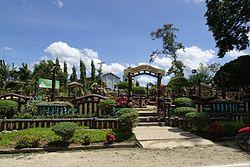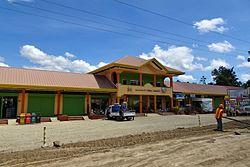Dagohoy | |
|---|---|
| Municipality of Dagohoy | |
 Dagohoy, Bohol | |
 Map of Bohol with Dagohoy highlighted | |
OpenStreetMap  | |
Location within the Philippines | |
| Coordinates: 9°55′N 124°17′E / 9.92°N 124.28°E | |
| Country | |
| Region | Central Visayas (Region VII) |
| Province | Bohol |
| District | 2nd District |
| Founded | 21 June 1956 |
| Barangays | 15 (see Barangays) |
| Government | |
| • Type | Sangguniang Bayan |
| • Mayor | Sofronio C. Apat |
| • Vice Mayor | Ma. Shirley A. Amodia |
| • Representative | Erico Aristotle C. Aumentado |
| • Electorate | 12,754 voters (2019) |
| Area | |
| • Total | 77.59 km2 (29.96 sq mi) |
| Elevation | 151 m (495 ft) |
| Population (2015 census) [3] | |
| • Total | 19,158 |
| • Density | 250/km2 (640/sq mi) |
| • Households | 4,170 |
| Economy | |
| • Income class | 5th municipal income class |
| • Poverty incidence | 35.18% (2015)[4] |
| • Revenue | ₱66,161,971.86 (2016) |
| Time zone | UTC+8 (PST) |
| ZIP code | 6322 |
| PSGC | |
| IDD : area code | +63 (0)38 |
| Climate type | tropical monsoon climate |
| Native languages | Boholano dialect Cebuano Tagalog |
Dagohoy, officially the Municipality of Dagohoy (Cebuano: Lungsod sa Dagohoy; Tagalog: Bayan ng Dagohoy), is a 5th class municipality in the province of Bohol, Philippines. According to the 2015 census, it has a population of 19,158 people. [3]
The town is named after Francisco Dagohoy.
The town of Dagohoy, Bohol celebrates its fiesta on February 10, to honor the town patron Our Lady of Lourdes.[5]
History
On 21 June 1956, the municipality of Dagohoy was created. Camilo Calceta was the first mayor.[6] The barrios constituting the new municipality were:[6]
| From the municipality of Carmen | ||
|---|---|---|
| 1. Colonia | 3. San Vicente | 5. Can-oling |
| 2. La Esperanza | 4. Villa Aurora | |
| From the municipality of Sierra Bullones | ||
| 1. Caluasan | 2. San Miguel | 3. Candelaria |
| From the municipality of Trinidad | ||
| 1. Mahayag | 2. Malitbog | 3. Cagawasan |
| 4. Santo Rosario | ||
| From the municipality of Ubay | ||
| 1. Babag | ||
Barangays
Dagohoy comprises 15 barangays:
| PSGC | Barangay | Population | ±% p.a. | |||
|---|---|---|---|---|---|---|
| 2015 [3] | 2010 [7] | |||||
| 071217001 | Babag | 6.7% | 1,278 | 1,388 | −1.56% | |
| 071217005 | Cagawasan | 4.9% | 948 | 1,044 | −1.82% | |
| 071217006 | Cagawitan | 3.5% | 665 | 612 | 1.59% | |
| 071217007 | Caluasan | 9.9% | 1,892 | 1,816 | 0.78% | |
| 071217002 | Can‑oling | 4.0% | 772 | 985 | −4.53% | |
| 071217003 | Candelaria | 5.5% | 1,057 | 1,006 | 0.95% | |
| 071217004 | Estaca | 2.8% | 537 | 538 | −0.04% | |
| 071217008 | La Esperanza | 5.2% | 997 | 1,085 | −1.60% | |
| 071217009 | Mahayag | 5.3% | 1,016 | 987 | 0.55% | |
| 071217010 | Malitbog | 8.5% | 1,633 | 1,509 | 1.52% | |
| 071217011 | Poblacion | 14.1% | 2,692 | 2,646 | 0.33% | |
| 071217012 | San Miguel | 14.4% | 2,754 | 2,819 | −0.44% | |
| 071217013 | San Vicente | 7.2% | 1,386 | 1,374 | 0.17% | |
| 071217014 | Santa Cruz | 4.7% | 891 | 850 | 0.90% | |
| 071217015 | Villa Aurora | 2.4% | 456 | 443 | 0.55% | |
| Total | 19,158 | 18,868 | 0.29% | |||
Climate
| Climate data for Dagohoy, Bohol | |||||||||||||
|---|---|---|---|---|---|---|---|---|---|---|---|---|---|
| Month | Jan | Feb | Mar | Apr | May | Jun | Jul | Aug | Sep | Oct | Nov | Dec | Year |
| Average high °C (°F) | 27 (81) | 28 (82) | 29 (84) | 30 (86) | 31 (88) | 30 (86) | 29 (84) | 30 (86) | 30 (86) | 29 (84) | 28 (82) | 28 (82) | 29 (84) |
| Average low °C (°F) | 22 (72) | 22 (72) | 22 (72) | 23 (73) | 24 (75) | 24 (75) | 23 (73) | 23 (73) | 23 (73) | 23 (73) | 23 (73) | 23 (73) | 23 (73) |
| Average precipitation mm (inches) | 98 (3.9) | 82 (3.2) | 96 (3.8) | 71 (2.8) | 104 (4.1) | 129 (5.1) | 101 (4.0) | 94 (3.7) | 99 (3.9) | 135 (5.3) | 174 (6.9) | 143 (5.6) | 1,326 (52.3) |
| Average rainy days | 18.0 | 14.1 | 17.1 | 16.8 | 23.7 | 25.7 | 25.8 | 23.3 | 24.2 | 25.9 | 24.0 | 20.6 | 259.2 |
| Source: Meteoblue [8] | |||||||||||||
Demographics
| Year | Pop. | ±% p.a. |
|---|---|---|
| 1960 | 6,699 | — |
| 1970 | 7,291 | +0.85% |
| 1975 | 8,578 | +3.31% |
| 1980 | 9,451 | +1.96% |
| 1990 | 13,121 | +3.34% |
| 1995 | 13,943 | +1.15% |
| 2000 | 16,845 | +4.14% |
| 2007 | 18,311 | +1.16% |
| 2010 | 18,868 | +1.10% |
| 2015 | 19,158 | +0.29% |
| Source: Philippine Statistics Authority [3] [7] [9][10] | ||
References
- ^ Municipality of Dagohoy | (DILG)
- ^ "Province: Bohol". PSGC Interactive. Quezon City, Philippines: Philippine Statistics Authority. Retrieved 12 November 2016.
- ^ a b c d Census of Population (2015). "Region VII (Central Visayas)". Total Population by Province, City, Municipality and Barangay. PSA. Retrieved 20 June 2016.
- ^ "PSA releases the 2015 Municipal and City Level Poverty Estimates". Quezon City, Philippines. Retrieved 12 October 2019.
- ^ "Bohol Festivals Timetable". "www.bohol-philippines.com". Retrieved 2019-03-14.
- ^ a b Executive Order No. 184 (21 June 1956), CREATING THE MUNICIPALITY OF DAGOHOY IN THE PROVINCE OF BOHOL (PDF)
- ^ a b Census of Population and Housing (2010). "Region VII (Central Visayas)". Total Population by Province, City, Municipality and Barangay. NSO. Retrieved 29 June 2016.
- ^ "Dagohoy: Average Temperatures and Rainfall". Meteoblue. Retrieved 9 May 2020.
- ^ Censuses of Population (1903–2007). "Region VII (Central Visayas)". Table 1. Population Enumerated in Various Censuses by Province/Highly Urbanized City: 1903 to 2007. NSO.
- ^ "Province of Bohol". Municipality Population Data. Local Water Utilities Administration Research Division. Retrieved 17 December 2016.
External links
- Dagohoy Profile at PhilAtlas.com
- Philippine Standard Geographic Code
- Municipality of Dagohoy
- Dagohoy
- Apalisok, Simplicio, Bohol With Tears Book 2. (Surigao BB Press: 1992)
- Tirol, Lumin "History of Bohol from Pre-Hispanaic Up to 1971". Doctoral Dissertation, University of Santo Tomas, 1975.
.svg.gif)
